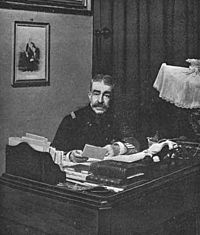Segismundo Bermejo y Merelo facts for kids
Quick facts for kids
Segismundo Bermejo y Merelo
|
|
|---|---|
 |
|
| Ministry of the Navy | |
| In office 4 October 1897 – 18 May 1898 |
|
| Monarch | Alfonso XIII of Spain |
| Prime Minister | Práxedes Mateo Sagasta |
| Preceded by | José María Beránger |
| Succeeded by | Ramón Auñón y Villalón |
| Personal details | |
| Born | March 9, 1832 San Fernando, Spain |
| Died | December 2, 1899 (aged 66) Madrid, Spain |
| Military service | |
| Allegiance | |
| Branch/service | |
| Years of service | 1846–1898 |
| Rank | |
| Commands | Ministry of the Navy Naval staff Home squadron Torpedo School |
| Battles/wars | Spanish–American War |
Segismundo Bermejo y Merelo (born March 9, 1832, died December 2, 1899) was a Spanish naval officer. He became an admiral and served as the head of the Spanish Navy. He was also the Minister of the Navy during the Spanish–American War.
He is best known for sending Rear Admiral Pascual Cervera y Topete and his fleet to Cuba in 1898. This decision led to the important naval Battle of Santiago de Cuba. Admiral Bermejo had to resign from his minister role after the Spanish fleet lost the Battle of Manila Bay to the U.S. Navy. He passed away the next year.
Segismundo Bermejo was born in 1832 in San Fernando, Spain. He joined the Spanish Navy when he was only 14 years old, in 1846.
He served in different places, including Cuba and the Philippines. Later, he became a professor at the Escuela Naval Militar, which is a naval school. He also led the torpedo school there.
Bermejo was important for creating the first group of torpedo boats in the Spanish Navy. These boats were later called destroyers. He then became the Chief of Staff of the Navy from 1896 to 1897. Before becoming the Minister of the Navy in 1897, he commanded the home fleet in Cádiz. In 1897, he also went to the Diamond Jubilee of Queen Victoria in the United Kingdom. This event celebrated her 60 years as queen.
The Spanish-American War
In the spring of 1898, there was growing tension between the United States and Spain. Admiral Bermejo believed that the Spanish Navy was strong enough to defeat the U.S. Navy.
He suggested a plan for Spain's war strategy. This plan included blocking the American East Coast and attacking Key West, Florida. However, his friend, Rear Admiral Pascual Cervera y Topete, thought this plan was not realistic. Cervera explained that Spain did not have the power to carry it out. He also said that the American fleet was much stronger than Spain's.
Despite this, Bermejo remained hopeful. On April 23, he held a meeting with Spanish naval officers to discuss the situation. They decided to send Admiral Cervera to Cuba and Puerto Rico. Cervera was waiting for their decision in Cape Verde at the time. The government approved Bermejo's plan. The only change was allowing Cervera, who would lead the fleet, to choose his exact destination in the region.
By early May, the Spanish Pacific fleet lost the Battle of Manila Bay on May 1. After this defeat, Bermejo changed his orders. He gave Cervera permission to return to Spain. At this point, Cervera's fleet was already in the Caribbean Sea. However, Cervera's ships did not have enough coal to make the trip back to Spain.
Later, the new naval minister changed Bermejo's order. He told Rear Admiral Cervera to stay in the harbor of Santiago de Cuba. Many people turned against Admiral Bermejo because of the Spanish defeat at Manila Bay. Because of this, he was forced to resign from his position.
Bermejo passed away in Madrid in 1899.
Personal Life
Admiral Bermejo was also a writer. He wrote literary works and was an author of science fiction stories.
See also
 In Spanish: Segismundo Bermejo para niños
In Spanish: Segismundo Bermejo para niños

